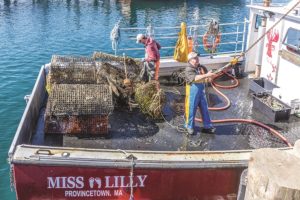Fishing remains very good for both striped bass and bluefish. They were both solidly inside the bay for a few days, providing some excellent fishing close to home. They’ve since headed down the backside, and as I write this they’re between the Race Point Light Station and the water tower.
The weather has been fairly cooperative this week. Although the winds have blown from the northerly quadrants, they’ve not been the strong winds that send water temperatures plummeting. The water is in fact still holding steady around the mid-60-degree mark.
Commercial tuna fishing has been good as well, but from what I am hearing, the price being paid for these fish has been very low. Six-dollar-a-gallon marine fuel and low prices for tuna are not a good combination.
Whale watching has been good up on Stellwagen Bank, with large groups of humpback whales seen actively feeding.

The latest news to rock the commercial lobster world comes from the Monterey Bay Aquarium’s Seafood Watch program, which is facing harsh criticism over its “red list” designation for American lobster — the species harvested in New England. It comes with a recommendation that seafood dealers and consumers avoid lobster altogether.
The Seafood Watch rating system has provided seafood retailers and food service providers with news of marine species population sustainability since 1999, listing fish it considers sustainable and responsibly harvested. It also makes recommendations on what species to avoid. The aquarium’s decisions carry a lot of weight in the industry.
This past February Monterey Bay hinted it might consider red listing Northeast lobster, not because the fishery isn’t healthy but because of the danger of entanglement in lobster trap lines for the highly endangered North Atlantic right whales.
The announcement, which became official on Sept. 6, has spurred an intense campaign to reverse this classification.
Some of the data suggest this recommendation might be an overreaction. According to the National Oceanic and Atmospheric Administration (NOAA), there have been 34 documented right whale deaths since 2017. Of those, 13 occurred in U.S. waters — that’s an average of just over two right whale deaths per year. Furthermore, three of the 13 deaths in American waters were documented vessel strikes and seven were from gear entanglement.
I understand the population numbers for right whales are perilously low — there are thought to be fewer than 350 individuals left in the world. But approximately one entanglement death per year in the U.S. does not, in my opinion, justify red listing an entire regional fishery. Here is one way this doesn’t add up: The NOAA numbers show Maine has not had a single entanglement in the period Monterey Bay is reviewing. And yet Monterey’s move could have a monumentally disastrous effect on Maine’s lobster industry.
Another thing missing from this story is how much our fishermen are doing to avoid entanglements: removing “ghost gear,” doing 10 m.p.h. in the bay, and, most significantly, holding back until May, which keeps their gear out of the water when the whales are here.
The pushback from lobstermen is not surprising. When it comes to management of marine life, the way I see it, fishermen have faced a history of policies that overreach as they try to rectify problems. Meanwhile, the shipping industry carries on, business as usual.
Right whales are endangered and certainly deserve protection, but I’d like to see a recommendation that recognizes New England lobstermen’s efforts and successes.



